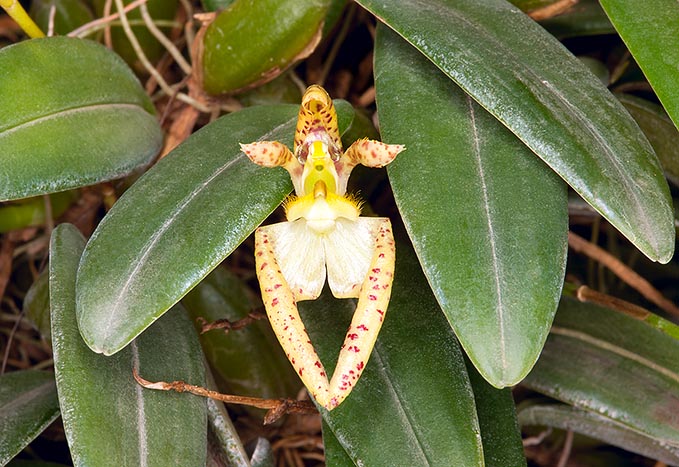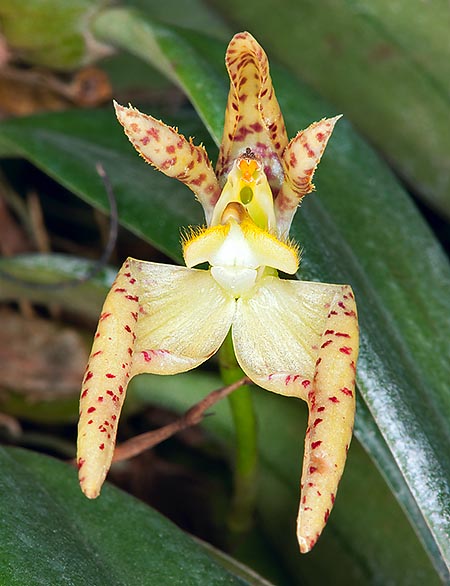Family : Orchidaceae

Text © Pietro Puccio

English translation by Mario Beltramini

Bulbophyllum lasiochilum is a small and easy to cultivate tropical epiphytic orchid © Giuseppe Mazza
The name of the genus is the combination of the Greek terms “bulbos” = bulb and “phyllon” = leaf, with reference to the leaves growing at the apex of the pseudobulbs; the name of the species is the combination of the Greek terms “lasios” = woolly, hairy and “cheilos” = labrum, with the reference to the long hairs on the sides of the labellum.
Common names: shaggy lipped (English).
The Bulbophyllum lasiochilum E.C.Parish & Rchb.f. (1874) is an epiphytic with ovoid pseudobulbs, speced of about 3-4 cm on a thin creeping rhizome, 2-3 cm long and 1,5-2 cm broad, carrying at the apex a single ovate-oblong leaf, coria- ceous, 4-6 cm long and 2 cm broad.
The flowers are tiny, solitary, about 3,5 cm tall and 2 cm broad, on an erect peduncle starting from the base of the pseudobulb, about 4-7 cm long, dotted with purple.

The flowers smell of strawberry and last 2-3 weeks © Giuseppe Mazza
The dorsal sepal is linear-lanceolate, bent forward, of a purple colour, 1,5 cm long and 0,5 cm broad, the lateral ones are falcate, curved, converging at the apex, 2-3 cm long and 0,8 cm broad, of yellowish colour with purple spots.
The petals are falcate, with finely indented margins, 1,2 cm long and 0,3 cm broad, of purple colour, the labellum is trilobed, of purple colour too, 0,5-1 cm long, with long purple hairs on the lateral lobes; there are forms of a paler colour, up to pale yellow with purple spots.
The flowers emit a slight strawberry fragrance and last 2-3 weeks. It reproduces by seed, in vitro, and by division, with each section provided with at least 3-4 pseudobulbs. Miniature orchid of easy cultivation and reproduction, which tillers quite rapidly, it requires medium high temperatures, with night lows not less than 15-16 °C, slight shade and high humidity, 60-70%, with always moving air.
Waterings must be frequent and abundant; it has not a precise resting period, but in winter it is good to slightly reduce their frequency, but without drying up completely. For the waterings and the nebulisations rain water is to be utilized, or water gotten by reverse osmosis, or demineralised; the fertilizations, duly distributed in function of the vegetative status of the plant and alternated, in way to avoid salts accumulation at the roots, are to be done preferably with hydrosoluble balanced products, with microelements, at half dosage, or less, than what suggested on the package.
It may be mounted on bark, trunks cork or arborescent ferns roots rafts or placed in low and wide baskets, in order to allow its expansion, with much draining and aerated compost which may be formed by medium sliced bark fragments.
The species is reported in the appendix II of the CITES (species whose trade is internationally ruled).
Synonyms: Cirrhopetalum lasiochilum E.C.Parish & Rchb.f. (1874); Phyllorkis lasiochila (E.C.Parish & Rchb.f.) Kuntze (1891); Cirrhopetalum breviscapum Rolfe (1905); Bulbophyllum breviscapum (Rolfe) Ridl. (1907).
→ For general notions about ORCHIDACEAE please click here.
